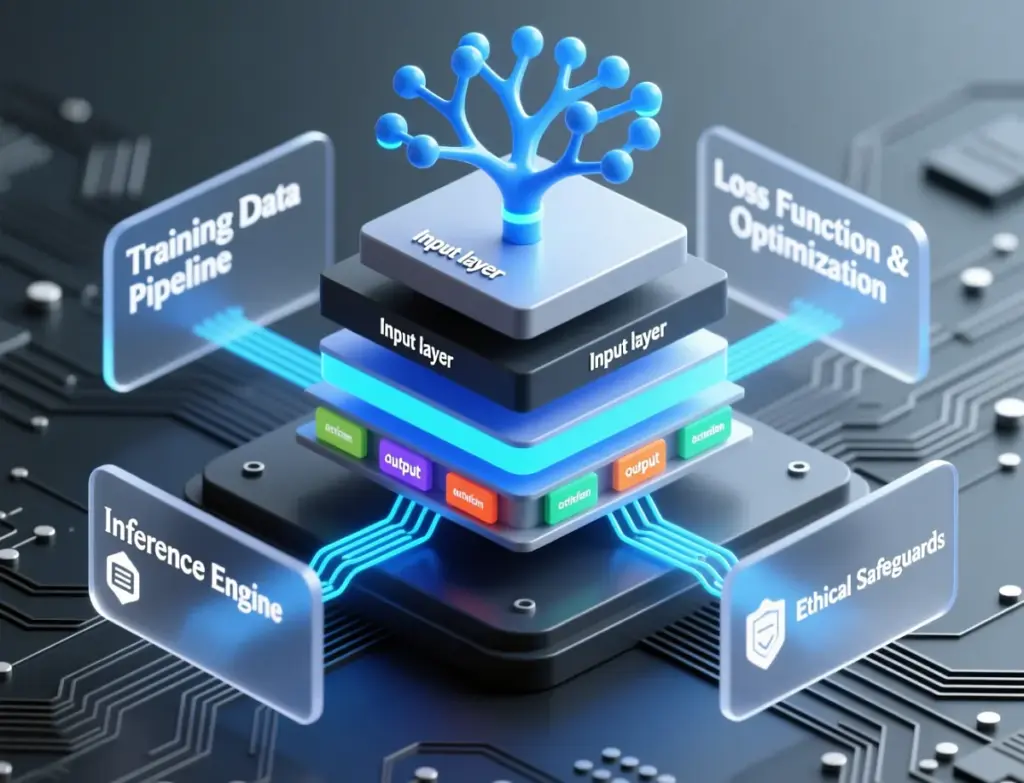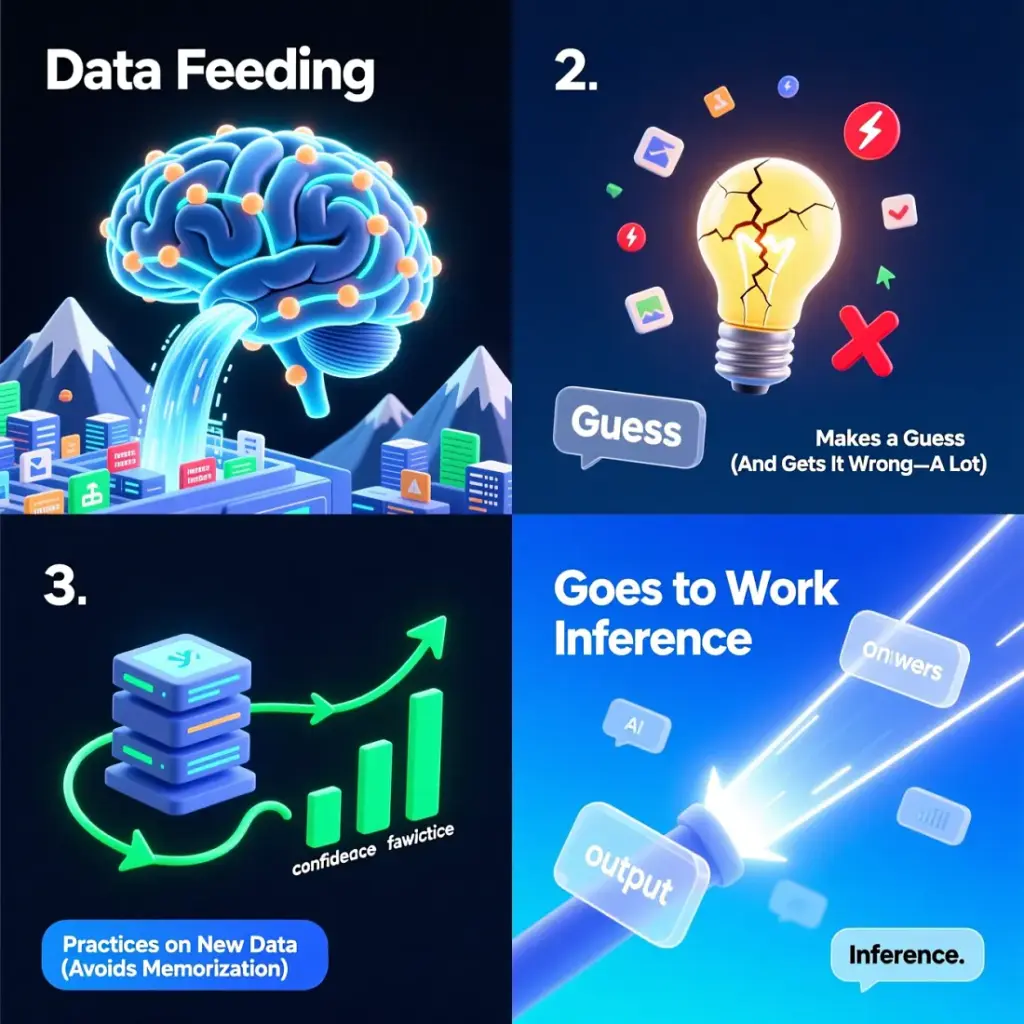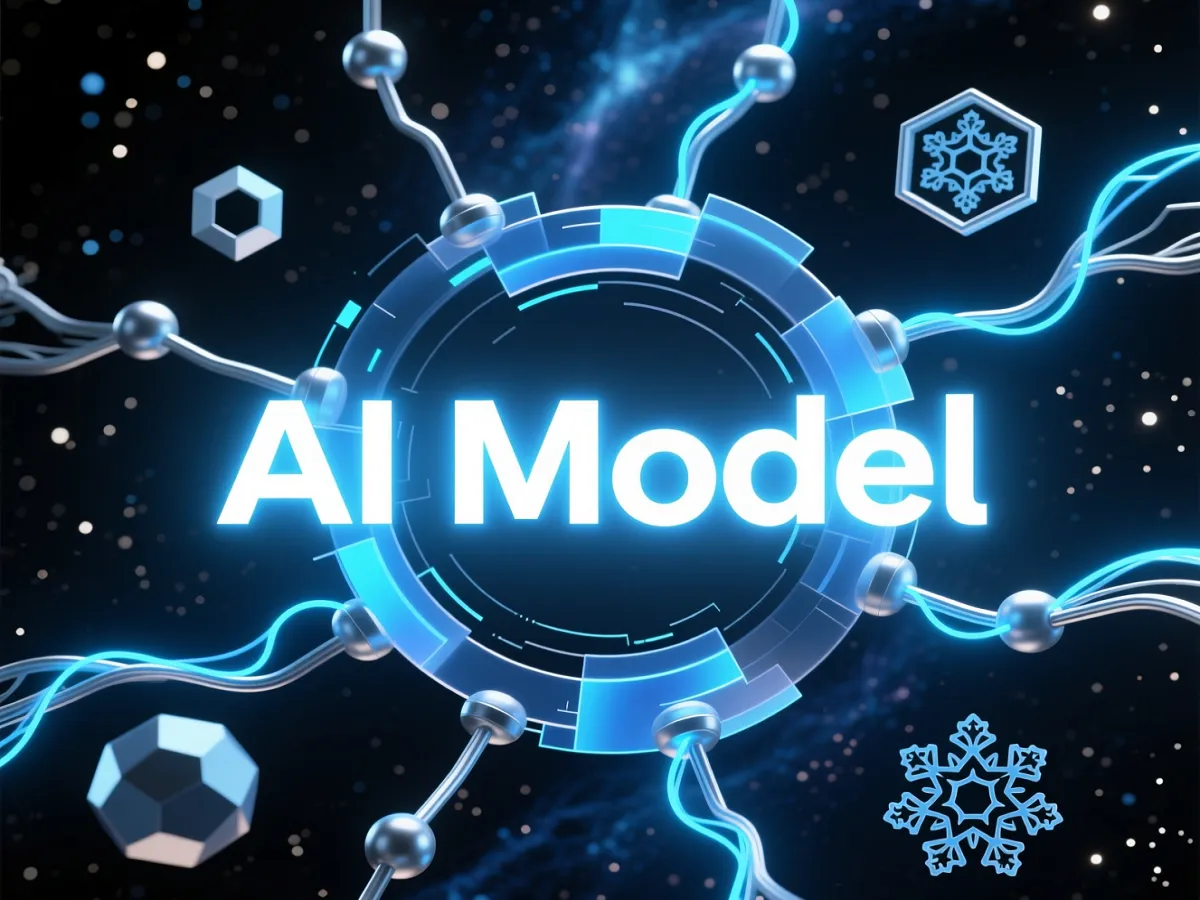You’ve probably asked Siri for the weather, gotten a Netflix recommendation, or had Gmail auto-sort your spam, all without wasting time or thinking twice. But behind each of those “smart” moments is something quietly doing the heavy lifting: an AI model.
Well! I’ve spent years building and studying these models, and here’s the truth: they’re not magic. They don’t “think.” They don’t “know.”
What they do is learn patterns from mountains of data, then use those patterns to make educated guesses. Think of them less like robots with opinions, and more like supercharged calculators trained to spot trends you’d miss.
In this post, I’ll break down exactly what an AI model is and how it actually works, without drowning you in buzzwords or textbook definitions.
What is an AI Model? (Definition)
So, what is an AI model? At its core, it’s a set of math rules—yes, math. Data shapes these rules to spot patterns and make decisions. Think of teaching someone to recognize handwritten digits.
You show them thousands of examples: “This squiggle is a 3… this loop is a 9…” As they see more and more, they start to notice what sets a 7 apart from a 1. An AI model works similarly. It uses numbers, probabilities, and adjustable settings instead of eyes and memory.
We call these settings “parameters,” but you can think of them as dials that it tweaks to get things right. It’s not alive and doesn’t understand. It just gets really, really good at connecting dots, so good that it can predict, classify, or even create new things that feel surprisingly human.
According to Yann LeCun, Turing Award recipient and Meta’s Chief AI Scientist,
A machine learning model is a program that has been trained to recognize patterns in data and make predictions based on those patterns.
The trick is simple: it learns from examples, not instructions. Provide enough good data, and it figures out the rules by itself. Even Geoffrey Hinton, the “Godfather of Deep Learning,” once joked (half-seriously):
We don’t really know how these models work. We just know they do, better than we expected.
Core Components of an AI Model

Step inside the world of Artificial Intelligence, where mystery meets machinery. Each component is a vital gear in this intricate machine. Tweak one piece, and the entire model dances to a new tune. Here’s what fuels this marvel:
1. Input
This is the raw material, the data you feed it. Could be a photo, a sentence, a stock price, even a heartbeat reading from a wearable. Whatever the model’s designed for, that’s what it needs to see first. Garbage in? You know the rest.
2. Architecture
Think of this as the model’s skeleton—the blueprint that decides how information flows. Is it a simple linear setup? A deep neural network with dozens of layers?
The architecture shapes what the model can learn. It’s like choosing between a bicycle and a cargo truck before a road trip. One’s great for short distances; the other hauls heavy loads.
3. Parameters (or “weights”)
These are the knobs the model turns during training. Each one represents a tiny decision, how much to “trust” a certain feature. In a face-recognition model, one parameter might control how much emphasis to put on eye spacing versus nose shape.
Modern models have billions of these. And yes, they’re all adjusted automatically, no human manually tuning them (thank goodness).
4. Output
This is the model’s answer. A prediction (“87% chance of rain”), a classification (“this is a cat”), or even something it dreamed up (“Here’s a new logo based on your brand”). The output only makes sense if the input, architecture, and parameters are aligned.
How Does an AI Model Work? (The Learning Process)
Alright, now that you know what an AI model is, let’s discuss how it learns. An AI model begins completely clueless. Imagine giving a dictionary to a newborn and expecting poetry. It just won’t happen… until you train it.
Training is where the real work happens. It’s not about flashy demos or viral tweets. It’s about the quiet, repetitive, data-driven effort. Here’s how this looks in real-life situations:

Step 1: You Feed It Data (Lots of It)
Before any learning begins, you need examples. Want a model to detect tumors in X-rays? You’ll need thousands, ideally tens of thousands of labeled scans: “This one’s cancerous. This one’s clean.”
The better and more diverse your data, the smarter your model becomes. Skimp here, and you’ll bake bias or blindness right into the system.
(Side note: This is why your phone’s face unlock works great on you… but sometimes fails on your cousin with darker skin. Bad data = blind spots.)
Step 2: It Makes a Guess (And Gets It Wrong—A Lot)
At first, the model’s predictions are basically random. It sees a photo of a dog and says “73% cat.” You show it the word “happy” and it predicts the next word is “refrigerator.”
But that’s okay.
Every time it’s wrong, it calculates how wrong it was with a loss function (fancy term for “error score”). Then, it uses a method called gradient descent, no need to stress about the name. This method nudges all those internal parameters slightly in the direction that makes it less wrong.
Think of it like tuning a guitar by ear: pluck, listen, adjust, pluck again. Over and over. Only instead of six strings, it’s adjusting billions of tiny dials. And instead of music, it’s chasing accuracy.
Step 3: It Practices on New Data (So It Doesn’t Just Memorize)
Beginners often fall into a trap: overfitting. This means the model memorizes answers from the dataset instead of learning. To avoid that, we split data into three buckets:
– Training set: where it learns
– Validation set: where we tweak settings and check for overfitting
– Test set: the final exam it’s never seen before
Step 4: It Goes to Work (Inference)
Once trained, the model is ready for the real world. We call this phase inference, a fancy word for “making predictions on new stuff.”
You type a message into your keyboard, and the model suggests the next word.
Upload a photo, and it tags your friends.
You ask a voice assistant for traffic updates—and it responds in real time.
All of that? That’s inference. Fast, silent, and happening millions of times a second across the planet.
Some Common AI Model Questions
Let’s address the most common questions I hear. People often ask these after seeing a viral AI demo or reading a scary headline over coffee. These questions are not just theory. They reflect real human concerns and deserve clear answers.
“Are AI models conscious?”
No. Not even close.
AI models don’t have desires, awareness, or inner life. They don’t want to help or harm. They reflect the data they’re fed. If they say something weird, that’s because they found a pattern in human behavior and repeated it.
“Do they work like the human brain?”
Kind of… but not really.
Early neural networks were inspired by the brain. Today’s models are complex statistical engines. The brain uses electricity, chemicals, and experience. An AI uses matrix multiplications and internet text. One evolved over millions of years. The other trains over a weekend.
So, inspiration? Sure. Replication? Not even in the same universe.
“Can anyone build an AI model these days?”
Yes and that’s both exciting and a little terrifying.
Thanks to open-source tools, high school students train image classifiers and indie developers fine-tune chatbots for niche hobbies.
But here’s the catch: building a model is easy. Building a good, safe, reliable one? That requires skill, ethics, and a focus on data quality. Anyone can bake a cake. Not everyone knows when the ingredients are bad.
“If it’s just math, why does it sometimes ‘hallucinate’?”
Great question.
AI doesn’t make things up like humans do. It fills in gaps with the most likely answer based on its training data. If you ask about the 2025 World Cup winner, it might make one up because it’s seen a winner for every previous Cup. It’s not lying, just overconfident.
Think of it like a kid who’s read every sports almanac—but has never heard of the future. They’ll give you an answer… just not a true one.
Finishing Lines…
So where does that leave us? An AI model isn’t some mystical oracle. It’s not Skynet in disguise. It’s a tool—powerful, yes, but built from math, shaped by data, and limited by what we feed it and how we design it.
What makes it revolutionary isn’t consciousness or creativity in the human sense. It’s scale. The ability to find patterns across billions of data points faster than any team of experts ever could. That’s why it’s transforming medicine, climate science, art, logistics, you name it.
But here’s what I keep coming back to, after years in the lab: the model is only as good as the questions we ask it and the care we put into building it.
Garbage data? Biased outcomes. Rushed training? Fragile predictions. No human oversight? That’s how things go sideways.

